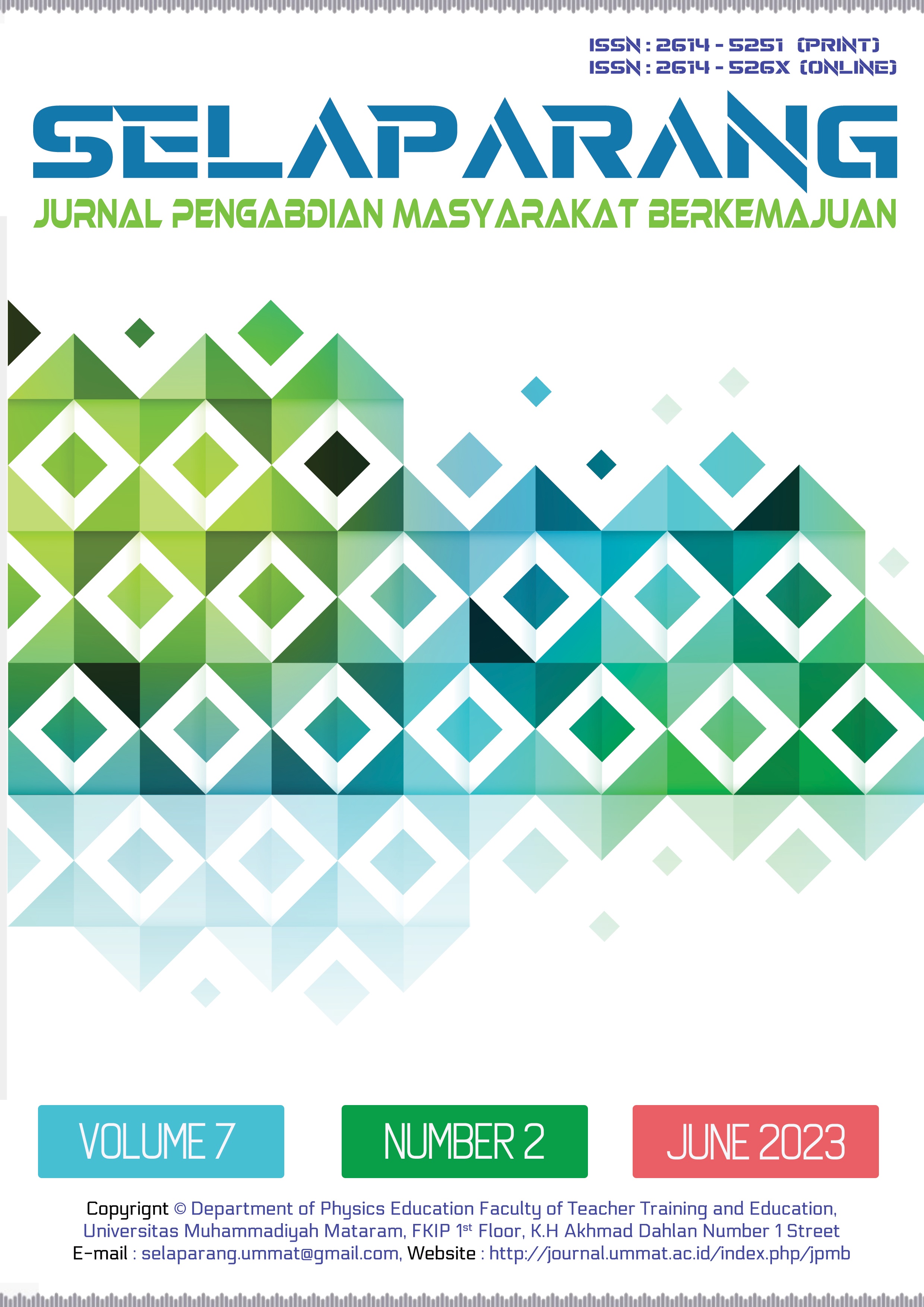PEMANFAATAN SAMPAH GELAS PLASTIK MENJADI BUNGA HIAS BERNILAI JUAL
DOI:
https://doi.org/10.31764/jpmb.v7i2.14711Keywords:
garbage plastic cups, decorative flowers, entrepreneurship, selling value.Abstract
ABSTRAK
Pemanfaatan sampah gelas plastik menjadi kerajinan tangan bernilai jual. Tujuan program kreativitas mahasiswa – kewirausahaan (PKM-K) adalah membangkitkan motivasi mahasiswa untuk berwirausaha dalam mengelola gelas plastik menjadi kerajinan tangan berupa hiasan meja yang bernilai jual. Produk berupa gelas plastik dapat menambah estetika ruangan, digunakan juga sebagai aksesoris meja. Metode pelaksanaan program ini adalah input, proses (produksi), output, dan evaluasi. hasil program ini adalah input, melakukan survey pasar terlebih dahulu untuk mengetahui kondisi pasar. Selanjutnya melakukan study kelayakan usaha yang di jalankan.dan tahap terakhir adalah pemilihan bahan yang tidak mudah rusak dan berkualitas tinggi yang akan diproduksi. Proses (Produksi), proses pembuatan gelas plastik dimulai dari persiapan bahan dan alat sampai gelas plastik siap dipasarkan. Output, yaitu hasil kerajinan tangan gelas plastik yang siap digunakan dan dipasarkan kepada konsumen. Yang terakhir adalah evaluasi, yaitu tahapan ini dilakukan pada saat produksi produk gelas plastik telah selesai digunakan. Pada tahap ini akan meninjau tentang kekurangan-kekurangan apa saja yang membuat konsumen tidak puas dengan produk kami. Kesimpulam program PKM-K pemanfaatan gelas plastik menjadi kerajinan tangan yang bernilai jual dapat memberikan keterampilan kepada mahasiswa khususnya bagi kami kelas A3 Manajemen UMP dan Dosen UMP dengan pemahaman konsep wirausaha yang komprehensif, dan membangun semangat mahasiswa untuk tetap berbisnis.
Â
Kata Kunci: gelas plastic; bunga hias; wirausaha; bernilai jual.
Â
ABSTRACT
Utilization of plastic cup waste into handicrafts worth selling. The aim of the student creativity program – entrepreneurship (PKM-K) is to generate motivation for students to become entrepreneurs in managing plastic cups into handicrafts in the form of table decorations that are worth selling. Products in the form of plastic cups can add to the aesthetics of the room, also used as table accessories. The methods of implementing this program are input, process (production), output, and evaluation. The results of this program are input, conducting a market survey first to find out market conditions. Then carry out a feasibility study of the business being carried out. And the last stage is the selection of materials that are not easily damaged and of high quality to be produced. Process (Production), the process of making plastic cups starts from the preparation of materials and tools until the plastic cups are ready for market. Output, which is the result of handcrafted plastic cups that are ready to be used and marketed to consumers. The last is evaluation, namely this stage is carried out when the production of plastic cup products has been used. At this stage we will review any deficiencies that make consumers dissatisfied with our products. The conclusion of the PKM-K program is that the utilization of plastic cups into handicrafts that are worth selling can provide skills to students, especially for us in class A3 UMP Management and UMP Lecturers with a comprehensive understanding of the concept of entrepreneurship, and build student enthusiasm to stay in business.
Â
Keywords: garbage plastic cups; decorative flowers; entrepreneurship; selling value.
References
Abadi, S., Sulandjari, K., Nasution, N. S., Keguruan, F., Universitas, P., & Karawang, S. (2022). Jurnal Pengabdian Kepada Masyarakat J-Abdi Jurnal Pengabdian Kepada Masyarakat. 1(11), 3123–3132.
Adriansyah, A. F., Santi, A. U. P., Widyasari, N., & ... (2020). Pemanfaatan Limbah Gelas Plastik Menjadi Hiasan Dinding untuk Meningkatkan Kreativitas Masyarakat Jalan Lele Rt 03 Rw 05. Seminar Nasional Pengabdian Masyarakat LPPM UMJ. https://jurnal.umj.ac.id/index.php/semnaskat/article/view/8030
Arumi, E. R., Adani, S. I., Almuqorrobin, A. R., Cahya, Y. R. T., Widiyati, A., & Astuti, R. P. (2022). Digital marketing utilization as a marketing medium for recycled waste craft products. Community Empowerment, 7(1), 158–164. https://doi.org/10.31603/ce.4316
Daiyanti, V. M., Aini, N., Nurhaliza, B. I., & Purwanto, D. K. (2023). Pemanfaatan Limbah Kulit Rambutan Menjadi Produk Teh di Desa Karang Bayan Kecamatan Lingsar Kabupaten Lombok Barat. 2–7.
Hikmawati, A., Haritsyah, H., Prabowo, M. Y., Hafiz, A.-B., Sapitri, D., Martari, S., Nofiri, M., Widayanti, W., & Dari, R. W. (2020). Ppelatihan Pengelolaan Limbah Plastik Menjadi Kerajinan Tangan Guna Meningkatkan Kreatifitas Anak-Anak. Jurnal Pemberdayaan: Publikasi Hasil Pengabdian Kepada Masyarakat, 4(2), 131–138. https://doi.org/10.12928/jp.v4i2.1875
Mukramin, S., Syamsuri, A. S., Maymunah, Andini, P. M., & Putri, E. A. (2022). Pemanfaatan Sampah Anorganik Dalam Meningkatkan
Ekonomi Masyarakat Di Kel. Jagong Kab. Pangkep. Jurnal Pengabdian Kepada Masyarakat, 28(3), 308–315. https://jurnal.unimed.ac.id/2012/index.php/jpkm/article/view/41771/pdf
Name, P., Count, W., Count, C., Count, P., Size, F., Date, S., & Date, R. (2023). KELOMPOK 3 ( DRAF ARTIKEL ) -2 . docx Farhan Zaki 2216 Words 31 % Overall Similarity Excluded from Similarity Report Buket Bunga Bernilai Tinggi. 3.
Natal, R. M., Syariah, E., Islam, B., Natal, S. M., Syariah, M. B., Islam, B., & Natal, S. M. (2021). Jurnal abdidas. 2(2), 238–244.
Nurdilla, H., Oktaviola, A., Auliya, H., Selaras, P., & Titisari, P. W. (2020). Community Education Engagement Journal. Community Education Engagement Journal, 2(1), 73–82. http://journal.uir.ac.id/index.php/ecej
Prastyo, D., Purnomo, A. B., & Rahayaan, T. I. (2017). Pelaksanaan Program Bank Sampah Dalam Sistem Pengelolahan Sampah Di Desa Jogodalu Kecamatan Benjeng Kabupaten Gresik. Penamas Adi Buana, 01(1), 7–12.
Trianah, Y., & Sani, S. (2020). Pelatihan Pembuatan Kerajinan Tangan Menggunakan Limbah Rumah Tangga (Sampah Plastik) Di Kelurahan Nikan Jaya Kecamatan Lubuklinggau Timur I. JURNAL CEMERLANG : Pengabdian Pada Masyarakat, 2(2), 212–220. https://doi.org/10.31540/jpm.v2i2.1354
Downloads
Published
Issue
Section
License
The copyright of the received article shall be assigned to the journal as the publisher of the journal. The intended copyright includes the right to publish the article in various forms (including reprints). The journal maintains the publishing rights to the published articles.

Selaparang : Jurnal Pengabdian Masyarakat Berkemajuan is licensed under a Creative Commons Attribution-ShareAlike 4.0 International License.

